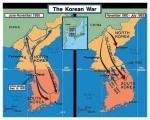
In August 1945, the Soviet Union’s Red Army occupied the northern half of Korea, following the surrender of Japan and a hastily-completed agreement with the Allies. As he would do in eastern Europe, Stalin moved to install a puppet leader in northern Korea. His choice, Kim Il-Sung, was a Korean-born communist who trained in China and volunteered with the Red Army. Kim’s elevation to the leadership was initially popular with locals, who were impressed by his credentials as an anti-Japanese resistance leader (which were greatly exaggerated) and his promises to initiate land reform. Backed by Moscow and supplied with Soviet equipment, Kim recruited other ex-soldiers to form the Korean People’s Army (KPA). He also consolidated his own power by isolating and removing political opponents. By 1949 Kim had become the undisputed dictator of North Korea. ‘Kim Il-Sung Thought’ became the fledgeling nation’s official ideology – and in some respects its state religion.
Kim Il-Sung was not content with dictatorship over the North, however; he coveted control of the entire peninsula. Kim believed South Korea was illegitimately ruled by puppets of the United States. The people there would welcome and embrace communism, given the chance. In the late 1940s, Kim spent months sabre-rattling and taunting the South Korean government. Behind the scenes, he lobbied Moscow and Beijing for authorisation to declare war on the South. After obtaining the approval of Joseph Stalin, Kim ordered an invasion of South Korea in June 1950. This attack sparked the Korean War, a three-year conflict that killed around three million people, more than half of whom were North Korean. The Korean War ended with the signing of an armistice in July 1953. It failed to reunify the peninsula, which remained divided into North and South, much as it had been before Kim’s invasion.

After the Korean War, Kim turned his attention to his own country. North Korea became a closed nation governed along Stalinist lines. Access in and out of the country became almost impossible, while information was tightly restricted by the state. Kim himself survived a September 1953 coup attempt; all eleven conspirators were arrested and probably executed. In response, he constructed a network of kwan li-so (labour camps) for the ‘re-education’ of political opponents. The personality cult focusing on the North Korean leader grew to remarkable extremes, with Kim reaching almost divine status. By 1960 there were an estimated 10,000 statues, portraits or murals of Kim Il-Sung in the capital Pyongyang alone. State propaganda and the media referred to Kim as ‘Great Leader’, a practice that continues in North Korea today.
“After the occupation of North Korea by the Soviets, the status of the landless and of common labourers improved overnight, while the life of the landlords and ‘Japanese collaborators’ turned into a nightmare. What was so remarkable was that threshold levels for confiscation were so low. In March 1946 Kim confiscated land without compensation and distributed it to tenant farmers and the landless. Any land holding in excess of five hectares (11 acres) owned by one family was considered “ill-gotten” through exploitative means. The entire property would be confiscated and the family was required to leave the village for some distant location. Such a low acreage threshold was not typical either in Russia or its satellites.”
Bong Lee, historian
Kim’s policies included a Soviet-style Five-Year Plan to modernise and industrialise North Korea’s economy. This program diverted resources from agricultural production and triggered a devastating famine, though it is impossible to know how many North Koreans perished. Internationally, North Korea became a pariah state, shunned by a majority of other nations. Since Kim was a firm Stalinist, Nikita Khrushchev‘s 1956 denunciation of Stalin rankled with him and caused a split between North Korea and the USSR. Kim retained an alliance with China and established friendly links with communist and non-communist dictators, including Erich Honecker (East Germany), Nicolae Ceausescu (Romania) and Colonel Muammar Gaddafi (Libya). North Korean trade was restricted to a handful of communist nations, mainly China. For the duration of his leadership, Kim engaged in angry rhetoric against South Korea, accusing its government of treachery and constantly talking of war. Several times he ordered North Korean agents, infiltrators and saboteurs across the border.

Kim Il-Sung ruled North Korea until his death in 1994. By this time he was the world’s last Stalinist dictator, a lonely remnant of the first decade of the Cold War. Kim’s cult of personality was so pervasive that his death generated wild scenes of emotion and grief in Pyongyang. As had occurred with his Vietnamese counterpart Ho Chi Minh, Kim’s body was embalmed and put on public display in the national capital. After three years of mourning, the dictatorship passed to Kim’s son, Kim Jong-Il, who had been born in Soviet Russia in 1941 or 1942 during his father’s service with the Red Army. Kim Jong-Il inherited his father’s cult of personality and ruled North Korea until his death in December 2011. Leadership has since passed to Kim Jong-un, who is Kim Il-Sung’s grandson. North Korea remains an isolated state, shunned by the world for its undemocratic government, military spending, human rights abuses and lack of freedoms. In recent times it has attracted world attention for its development of ballistic missiles, its nuclear weapons program and its posturing and threats against South Korea, Japan and the US.

1. Kim Il-Sung was a Korean-born Christian who later embraced communism, serving with the USSR in World War II.
2. Kim was installed by the Soviets as the leader of North Korea; by 1949 he had obtained dictatorial authority.
3. With Stalin’s approval, Kim ordered an invasion of South Korea in 1950, to extend his control over the peninsula.
4. He also initiated an intensive cult of propaganda and Soviet style five-year plans, which caused massive famines.
5. Kim Il-Sung’s rule continued until 1994, making him one of the last surviving communist leaders of the Cold War. However North Korea remains a Stalinist state, ruled by his son Kim Jong-Il and his grandson Kim Jong-Un.
Content on this page is © Alpha History 2018. This content may not be republished or distributed without permission. For more information please refer to our Terms of Use.
This page was written by Jennifer Llewellyn and Steve Thompson. To reference this page, use the following citation:
J. Llewellyn & S. Thompson, “North Korea”, Alpha History, accessed [today’s date], https://alphahistory.com/coldwar/north-korea/.
